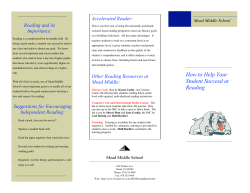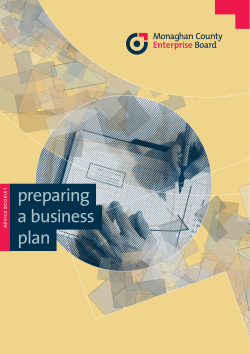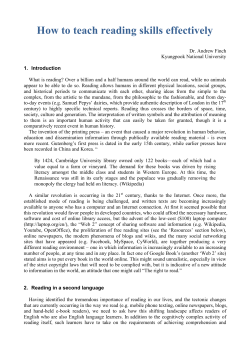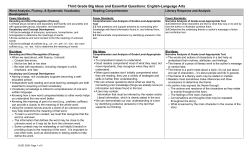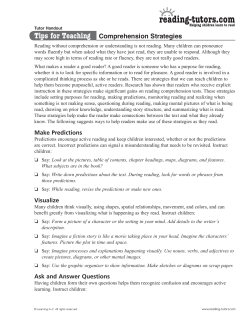
B Building Great Readers, One Good Habit At a Time.
Building Great Readers, One Good Habit At a Time. How to Build Great Readers VOLUME ONE, NUMBER ONE by Nancy Frey, Ph.D www.pearsonlearning.com uilding great readers begins in knowing what actions good readers take while reading (good habits) and what teachers can do to teach students to take those actions. In other words, “what do good readers do” and “what do good teachers of reading comprehension do?” B Celebration Press Reading: Good Habits, Great Readers is a unique research-based K–5 reading curriculum. Perfect for schools committed to a comprehensive and consistent What Do Good Readers Do? literacy program, it provides First we must look at, and understand how good readers comprehend what they read. Research shows that good readers have formed good reading habits and apply proven reading strategies. Paris, Wasik, and Turner (1991) described strategic reading as “a prime characteristic of expert readers because it is woven into the fabric of children’s cognitive development and is necessary for success in school” (p. 609). They further placed these reading strategies into three clusters: Before reading: previewing the text, making predictions during reading: identifying main ideas, making inferences, inspecting the text after reading: summarizing, reflecting (Paris, Wasik and Turner, 1991). Other studies have focused on other proven strategies, particularly in regard to the role of self generated questions, mental imagery (Borduin, Borduin, and Manley, 1994), and critical literacy (Luke, 2000). Over time, all of these strategies become the habits of readers who love to read, read with purpose, and understand what they read. The research has shown that these are the things good readers do. teaching and classroom materials to support whole-class and small-group reading instruction. Educators teach reading through an engaging, accessible teacher support system written for busy teachers which includes embedded professional development at point-of-use. The Seven Habits of Great Readers 1. Great readers see themselves as readers 2. Great readers make sense of text 3. Great readers use what they know 4. Great readers understand how stories work 5. Great readers read to learn 6. Great readers monitor and organize ideas and information 7. Great readers think critically about books Great Readers Begin by Developing Good Habits. SPRING 2006 What Do Good Teachers of Reading Comprehension Do? To bring students to the point of internalizing good reading habits, good teachers employ a number of explicit teaching techniques—the things good reading teachers do. Good teachers provide direct explanations. The teacher explains the comprehension strategy (Duffy, Roehler, Meloth, Vavrus, Book, “When looking for a comprehensive reading program, look for one that builds on a solid foundation of research, features reading comprehension strategies and offers an instructional model that begins with teacher modeling and ends with students working independently. In addition, a good program should help students build the habits of mind that great readers possess including seeing themselves as readers, making sense of text, knowing what they know, understanding how stories work, reading to learn, monitoring and organizing ideas and information, and thinking critically about texts.” Nancy Frey, Ph.D Putnam, and Wesselman, 1986). These direct explanations must involve both the procedure and the purpose of the strategy if students are to understand how the particular strategy can solve comprehension problems. As the National Reading Panel (NICHHD, 2000a) advised, reading comprehension instruction must also include modeling and supportive guidance if students are to acquire the tools needed to understand text. Good teachers think aloud to foster metacognition (teacher modeling). Baker and Brown (1984) described the role of metacognition in reading as “the ability to reflect on one’s own cognitive processes, to be aware of one’s own activities while reading” (p. 353). Effective reading teachers help students gain this kind of awareness by “thinking aloud,” by modeling “how good readers use comprehension strategies to understand” (Davey, 1983). In this manner, young readers gain insight into how they can use the tools of comprehension. Good teachers facilitate peer learning through partner talk (guided practice and application). Brown, Pressley,Van Meter, and Schuder (1996) investigated the effectiveness of peer discussion in deepening and refining understanding of reading comprehension strategies. Called “transactional strategies instruction,” these conversations follow teacher modeling and provide students with an opportunity to apply the strategy to a piece of text and discuss their decisions for doing so. For your FREE copy of the research paper for Celebration Press Reading: Good Habits, Great Readers, log onto www.GoodHabitsGreatReaders.com. References Baker, L., and Brown, A. L. (1984). Metacognitive skills and reading. In P. D. Pearson, R. Barr, M. L. Kamil, and P. Mosenthal (Eds.), Handbook of reading research (pp. 353-394). Mahwah, NJ: Lawrence A. Erlbaum. Borduin, B. J., Borduin, C. M., and Manley, C. M. (1994). The use of imagery training to improve reading comprehension of second graders. Journal of Genetic Psychology, 155(1), 115-118. Brown, R., Pressley, M., Van Meter, P., and Schuder, T. (1996). A quasi-experimental validation of transactional strategies instruction with low-achieving second-grade readers. Journal of Educational Psychology, 88(1), 18-37. Davey, B. (1983). Think aloud: Modeling the cognitive processes of reading comprehension. Journal of Reading, 27(1), 44-47. Duffy, G. G., Roehler, L. R., Meloth, M. S., Vavrus, L. G., Book, C., Putnam, J., and Wessleman, R. (1986). The relationship between explicit verbal explanations during reading skill instruction and student awareness and achievement: A study of reading teacher effects. Reading Research Quarterly, 21(3), 237-252. 1-800-321-3106 www.pearsonlearning.com Program Authors: Douglas Fisher, Ph.D. Nancy Frey, Ph.D. Adria Klein, Ph.D. Paris, S. G., Wasik, B. A., and Turner, J. C. (1991). The development of strategic readers. In R. Barr, M. L. Kamil, P. Mosenthal, and P. D. Pearson (Eds.), Handbook of reading research (Vol. II, pp. 609-640). Mahwah, NJ: Lawrence A. Erlbaum. Pearson, P. D., and Fielding, L. (1991). Comprehension instruction. In R. Barr, M. L. Kamil, P. Mosenthal, and P. D. Pearson (Eds.), Handbook of reading research (Vol. II, pp. 815-860). Mahwah, NJ: Lawrence A. Erlbaum. 1-800-321-3106 Celebration Press Reading: Good Habits, Great Readers
© Copyright 2025




